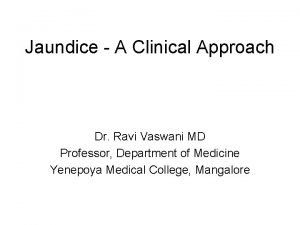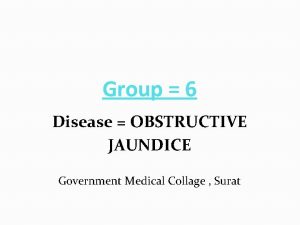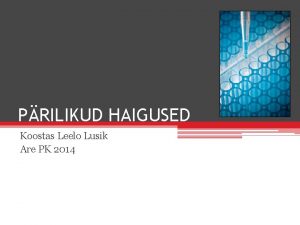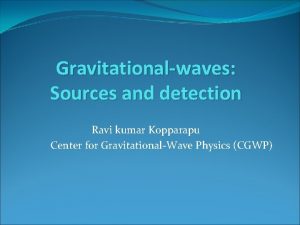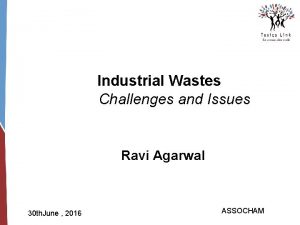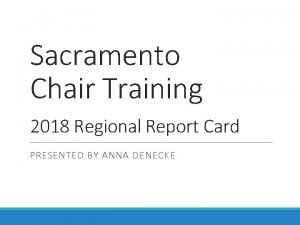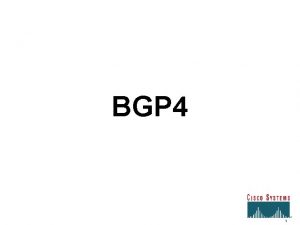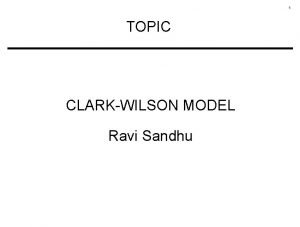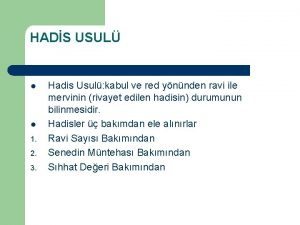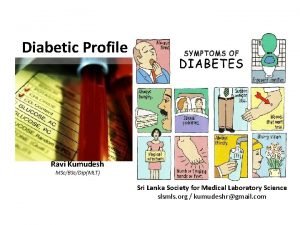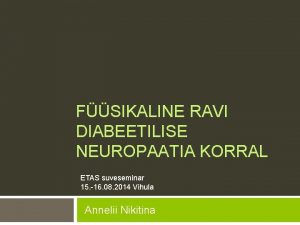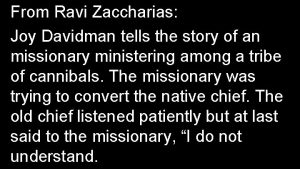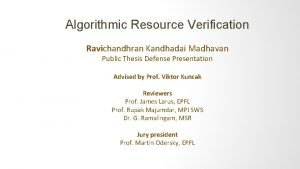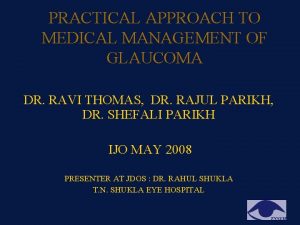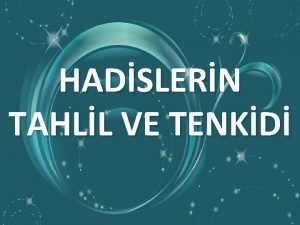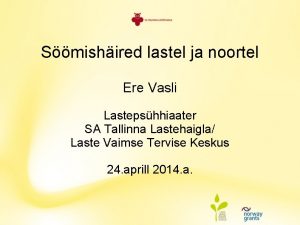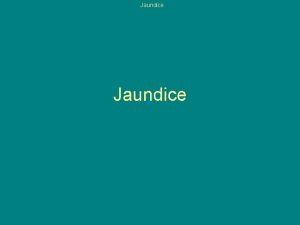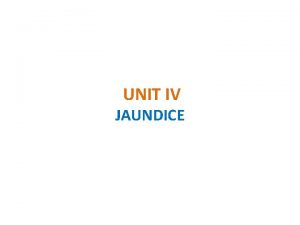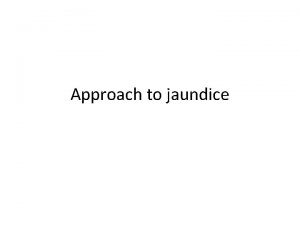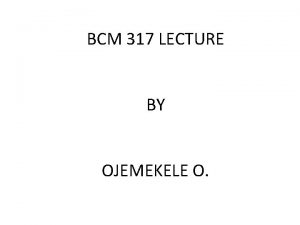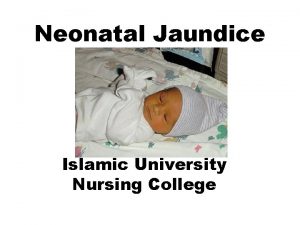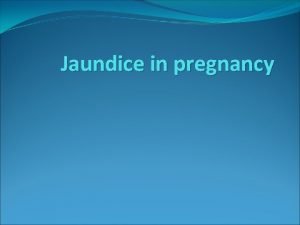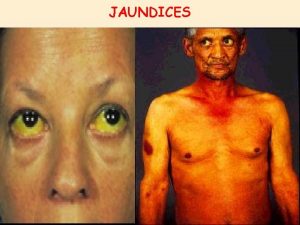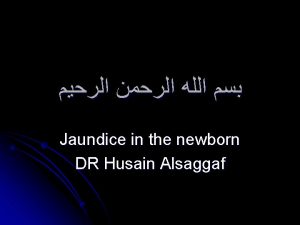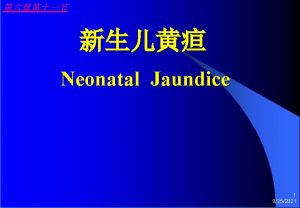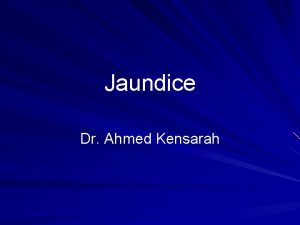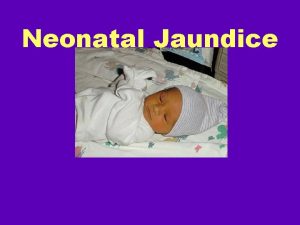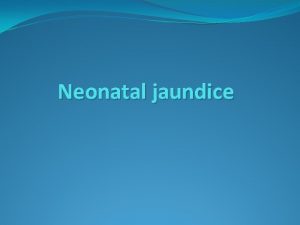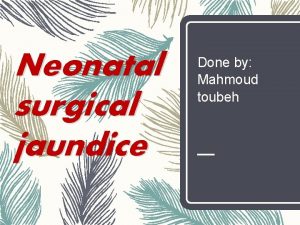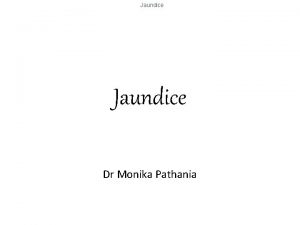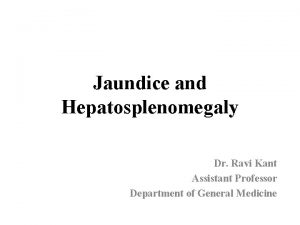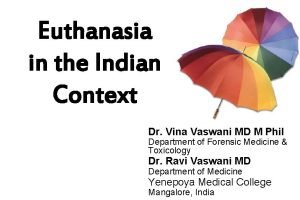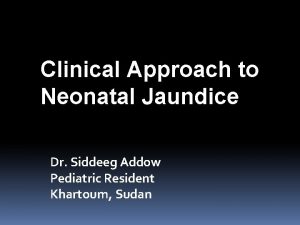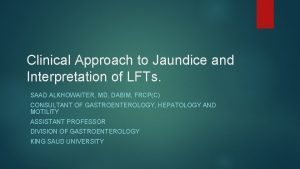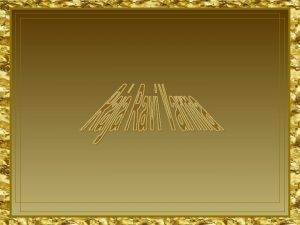Jaundice A Clinical Approach Dr Ravi Vaswani MD
























- Slides: 24

Jaundice - A Clinical Approach Dr. Ravi Vaswani MD Professor, Department of Medicine Yenepoya Medical College, Mangalore

Liver anatomy • Largest organ • 1 -1. 5 kg • 20% blood flow from hepatic artery oxygen rich • 80% from portal - nutrient rich • Hepatocytes 66% • Kuppfer (RE), Ito (fat-storing), endothelial, bile ductular 11/26/2020 Ravi Vaswani MD 2

Blood flow patterns 11/26/2020 Ravi Vaswani MD 3

Anatomical lobular structure 11/26/2020 Ravi Vaswani MD 4

Functional acinar structure 11/26/2020 Ravi Vaswani MD 5

Flow patterns • Blood from portal triad flows towards central hepatic vein (across zones 1, 2, 3) • Bile - secreted by hepatocytes - flows in a counter current (zones 3, 2, 1) • Hepatic sinusoids lined by cells that have loose junctions allow plasma (not cellular elements) to flow into the subendothelial space of Disse 11/26/2020 Ravi Vaswani MD 6

Functions • Synthesis of essential serum proteins (albumin, carrier proteins, coagulation factors, hormonal/growth factors • Production of bile and its carriers (bile acids, cholesterol, lecithin, phospholipids) • Regulation of nutrients (glucose, glycogen, lipids, amino acids) • Metabolism, conjugation of lipophilic compounds (bilirubin, anions, cations, drugs) 11/26/2020 Ravi Vaswani MD 7

Liver function tests • Bilirubin, ser albumin and prothrombin time are the most commonly assessed LFT • Bilirubin is a measure of hepatic conjugation and excretion • Albumin & Prothrombin time are measures of protein synthesis 11/26/2020 Ravi Vaswani MD 8

Classification of liver diseases • Hepatocellular (functions are suboptimal) – Viral hepatitis, alcoholic liver disease • Obstructive (Cholestatic) (bile flow stopped) – Gallstones, malignancies, primary biliary cirrhosis, drug-induced liver disorder • Mixed – Cholestatic stage of viral hepatitis – Drug-induced liver disorder 11/26/2020 Ravi Vaswani MD 9

Introduction • Yellowish discoloration of tissues (sclera, skin and mucus membranes) from deposition of bilirubin • Occurs only if serum hyperbilirubinemia • Either liver disease or hemolytic disorder • Slight increases in serum bilirubin are best detected by examining the sclerae, which have a particular affinity for bilirubin due to their high elastin content (procollagen IV) 11/26/2020 Ravi Vaswani MD 10

Intro contd… • Scleral icterus indicates a serum bilirubin of at least 3. 0 mg/d. L • A second place to examine is underneath the tongue • As bilirubin levels rise, skin will eventually become yellow in light-skinned patients & green if the process is long-standing due to oxidation of bilirubin to biliverdin • Confirm by examining urine (dark yellow) 11/26/2020 Ravi Vaswani MD 11

Differential Diagnosis • Carotenoderma: yellow color imparted to skin due to carotene • Use of the drug quinacrine • Excessive exposure to phenols • In jaundice, yellow discoloration of skin is uniformly distributed over the body • In carotenoderma the pigment is concentrated on palms, soles, forehead, & nasolabial folds. • Carotenoderma can be distinguished from jaundice by the sparing of the sclerae. 11/26/2020 Ravi Vaswani MD 12

Lab Estimation • The terms direct- & indirect-reacting bilirubin are based on the original van den Bergh reaction • Bilirubin is exposed to diazotized sulfanilic acid, splitting into two stable dipyrrylmethene azopigments that absorb maximally at 540 nm, allowing for photometric analysis • Direct fraction reacts with diazotized sulfanilic acid in the absence of an accelerator substance such as alcohol & provides an approximate determination of conjugated bilirubin 11/26/2020 Ravi Vaswani MD 13

• Total serum bilirubin is the amount that reacts after the addition of alcohol. • Indirect fraction is the difference between total and direct bilirubin; provides an estimate of unconjugated bilirubin in serum. • In van den Bergh method, normal serum bilirubin concentration is 17 mol/L (<1 mg/d. L) • Up to 30%, or 5. 1 mol/L (0. 3 mg/d. L), of the total may be direct-reacting (conjugated) bilirubin. • Total serum bilirubin concentrations are between 3. 4 and 15. 4 mol/L (0. 2 and 0. 9 mg/d. L) 11/26/2020 Ravi Vaswani MD 14

Bilirubin in the Urine • Unconjugated bilirubin is bound to albumin; is not filtered by kidney, and is not found in urine • Conjugated bilirubin is filtered – glomerulus; majority is reabsorbed by proximal tubules; a small fraction is excreted in the urine • Bilirubin found in urine is conjugated bilirubin. • Bilirubinuria implies liver disease • A urine dipstick test (Ictotest) gives the same information as fractionation of the serum bilirubin 11/26/2020 Ravi Vaswani MD 15

The Approach • Hyperbilirubinemia may result from – Overproduction of bilirubin – Impaired uptake – Impaired conjugation – Impaired excretion – Regurgitation of unconjugated or conjugated bilirubin from damaged hepatocytes or bile ducts 11/26/2020 Ravi Vaswani MD 16

• Unconjugated hyperbilirubinemia results from either overproduction, impairment of uptake, or conjugation of bilirubin • Conjugated hyperbilirubinemia is due to decreased excretion into the bile ductules or backward leakage of the pigment 11/26/2020 Ravi Vaswani MD 17

Clinical approach - Step 1 • Take detailed history; focus on drug intake • Past history of blood transfusion, jaundice • History of alcohol intake (80 gm for 10 years or 160 gm for 5 years) • Do a physical examination: look for hepatomegaly, splenomegaly, ascitis, lymph nodes, s/o chronic hepatocellular failure 11/26/2020 Ravi Vaswani MD 18

Step 2: Liver Function Tests (LFT) • • • Bilirubin (total and direct) AST & ALT Prothrombin time Proteins Alkaline phosphatase 11/26/2020 Ravi Vaswani MD 19

Step 3 • Is the hyperbilirubinemia predominantly conjugated or unconjugated in nature? Step 4 • Are other liver biochemical tests abnormal? 11/26/2020 Ravi Vaswani MD 20

Isolate direct hyperbilirubinemia • Consider – Dubin-Johnson syndrome – Rotor’s syndrome 11/26/2020 Ravi Vaswani MD 21

Isolated indirect hyperbilirubinemia • Consider – Gilbert syndrome – Crigler-Najjar syndrome – Hemolytic disorders – Drugs (Rifampicin, probenecid) 11/26/2020 Ravi Vaswani MD 22

Combined hyperbilirubinemia with other biochemical tests abnormal • AST & ALT out of proportion to Alk phos; consider hepatocellular pattern; viral markers, ceruloplasmin, tox profile • Alk phos out of proportion to AST/ALT consider cholestatic pattern; USG to rule out obstruction • CT abdomen if indicated • Consider liver biopsy 11/26/2020 Ravi Vaswani MD 23

Tips • Low albumin suggests chronic process such as cirrhosis or cancer • Normal albumin suggests more acute process such as viral hepatitis or choledocholithiasis • ↑ PT indicates either vitamin K deficiency due to prolonged jaundice and malabsorption of vitamin K or significant hepatocellular dysfunction • Failure of PT to correct with parenteral admin of vitamin K indicates severe hepatocellular injury 11/26/2020 Ravi Vaswani MD 24
 Ravi vaswani
Ravi vaswani Dd jaundice
Dd jaundice Ashish vaswani
Ashish vaswani Ravi and minu architects
Ravi and minu architects Handful of rice characters
Handful of rice characters Kurttummus ravi
Kurttummus ravi A gift of chappals mind map
A gift of chappals mind map Ravi kumar kopparapu
Ravi kumar kopparapu Ravi agarwal md
Ravi agarwal md Ravi kumar sacramento
Ravi kumar sacramento Ravi chandra cisco
Ravi chandra cisco Ravi raj production
Ravi raj production Clark-wilson model
Clark-wilson model Senedin müntehası
Senedin müntehası Ravi patel hawkeye hotels
Ravi patel hawkeye hotels Microalbimin
Microalbimin Perifeerse neuropaatia ravi
Perifeerse neuropaatia ravi Ravi zaccharias
Ravi zaccharias Ravi kandhadai madhavan
Ravi kandhadai madhavan Indentation gonioscopy
Indentation gonioscopy Metin tenkidinde ölçütler
Metin tenkidinde ölçütler Ravi sinha iit bombay
Ravi sinha iit bombay Ravi micro
Ravi micro Ravi credit card
Ravi credit card Ere vasli
Ere vasli
